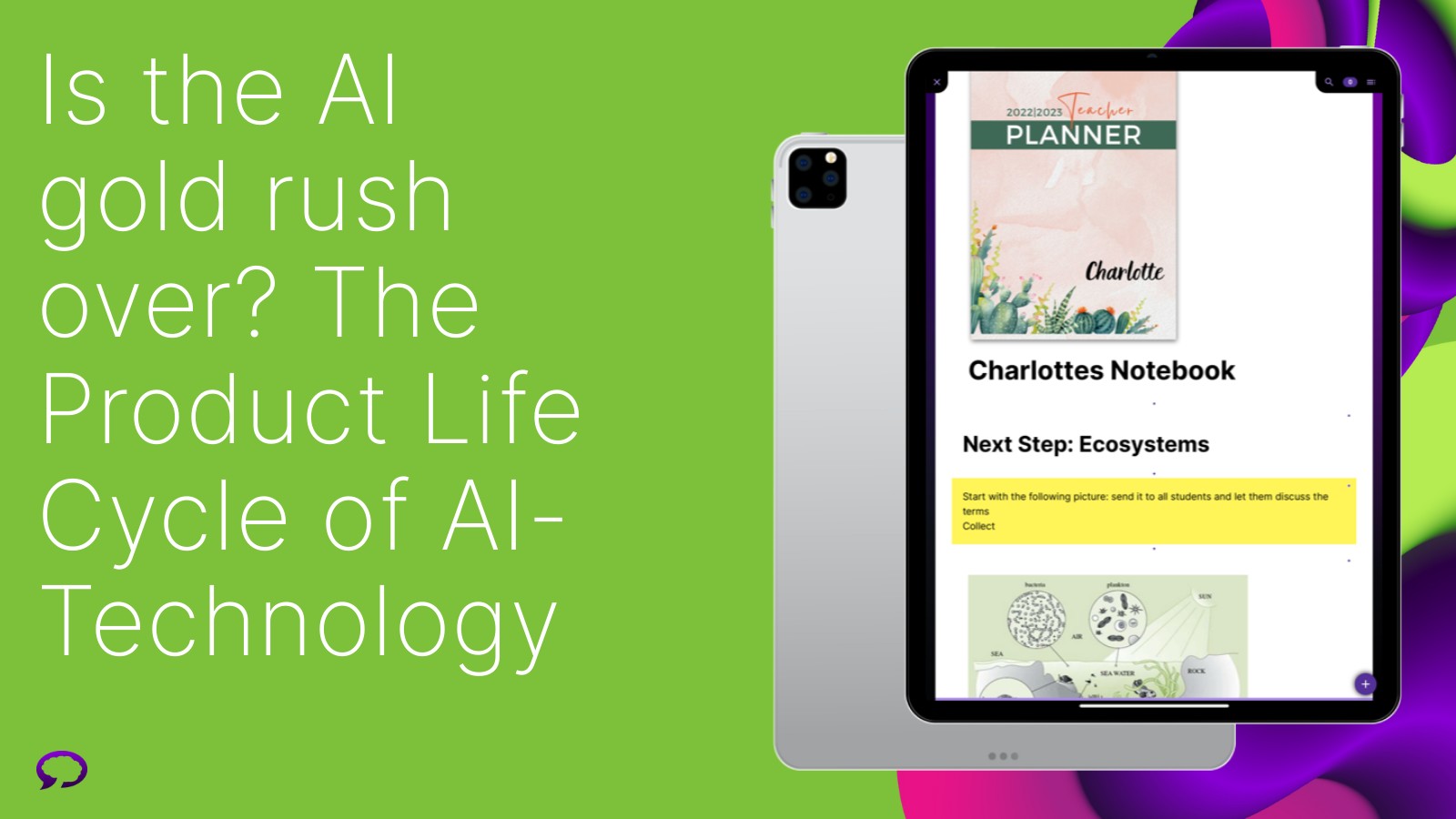Are you curious about the future of AI? Last year, AI technologies took off. With the opening of ChatGPT, we all suddenly experienced what generative language models can do. Abstract artificial intelligence suddenly had a face and became accessible. Now AI is everywhere. In writing, in images, in programming. But also in music, in videos, in web design. There is no service or product that does not have a bit of AI in it.
Many people already feel saturated and long for a simpler world. For many, AI is also a cost factor. Every tool costs money, and familiar tools suddenly become more expensive with AI. We also tend to ignore the fact that AI, like cryptocurrencies, is driving our global energy consumption to unprecedented levels. The massive computing power required is competing with our efforts to reduce CO2 production and save energy.
So how should and will AI evolve?
A simple model: the product lifecycle
Let’s first try to locate AI technologies in their life cycle. The product lifecycle model has proved useful for understanding the different stages a product goes through from its introduction to its demise. The model distinguishes between 4 or 5 phases. The maturity phase is sometimes combined with the saturation phase.
- Introduction phase: In this phase, the product is introduced to the market. It may take a while for the product to establish itself in the public market and sales are often low.
- Growth phase: Once the product is accepted, it experiences rapid growth. Sales increase sharply and the product begins to make a profit.
- Mature phase: This is when sales peak. The product is established in the market and competition increases.
- Saturation phase: The product faces strong competition and price pressure. Demand for the product may decline as it becomes integrated into people’s daily lives.
- Decline / Degeneration Phase: In this phase, sales decline and the product may be withdrawn from the market, often due to outdated features or better competition.

Where do we place AI technologies in this product cycle?
Is AI still growing?
It took a long time for AI applications to reach the mainstream market. But then it took off like a rocket. Last year, AI had more to do with us than any other technology topic for a long time. There is hardly an area of life where AI is not present.
Today – a year after the spectacular start – it is difficult to determine the exact status of AI technology in the product lifecycle, as AI can be at different stages in different areas. Some aspects of AI, such as machine learning and data analytics, are widely used and could be in the maturity or even saturation phase. Other aspects, such as advanced autonomous systems, may still be in the deployment or growth phase. Overall, however, AI technology is still likely to be a rapidly evolving field with significant potential for future growth and innovation.
…or is the AI-market already saturated?
But there are also some aspects that suggest to me that the peak of AI technologies may already have been reached or even passed:
- Increased competition: There are too many companies and startups developing and implementing AI technologies. The market is saturated. There will be consolidation and displacement.
- Price pressure: With increased competition, there could be price pressure as companies try to offer their products at competitive prices. Only offerings with a solid business model will survive.
- Shift from freemium to premium: Products that were once free are now paid for. While this is a solid business model, it may not be appreciated by customers. And without customers, it won’t work.
- Integration into our daily lives: AI technologies are becoming more and more part of our daily lives, from voice assistants to recommendation systems in online stores. Small, innovative solutions will disappear. The big players have it easier because of their market power. But even they have to deliver quality. Customers are now used to innovative concepts and expect them in their everyday products.
And what about the training market? I sensed a gold rush there last year. There was a big need for training. I think, there will be a change: Gone are the days when many training courses were just about learning about different AI technologies. What is needed now is specific application knowledge in the context of one’s own everyday life.
Maturity is good
Maturity is the beginning of a constant evolution. Gone are the hype tools, super bargains and unrealistic market promises. We are now in the phase where the wheat is separated from the chaff. Many offerings and tools that have sprung up quickly will disappear as users become more sophisticated. They can ask questions themselves, have had their own experiences with AI models and can set up more complex workflows. They no longer need the “entry level” offerings that were often promised at unrealistic prices in the growth phase to keep the barrier to the new technology low.
In addition, many AI applications are now integrated into the tools we use every day. Users are therefore happy to use their familiar tools and no longer need the “promising” special tools.
Now come the important and good ideas that are driving the AI world forward.
Platforms like Get More Brain, for example, are carefully considering which features will make sense for knowledge management in the future. We are certain that artificial intelligence (AI) will play a decisive role in knowledge management in the future, both in professional and personal everyday life. Here are some applications:
- Automated content curation: AI can help gather and curate relevant and timely information from a variety of sources. This can help employees stay up to date without having to spend time researching.
- Predictive analytics: AI can identify patterns and trends in large amounts of data, leading to more informed and forward-looking decisions.
- Intelligent search: AI can simplify and speed up the search for information by identifying relevant documents, experts and resources within the organisation.
- Personalised learning paths: AI can create personalised learning paths based on past learning behaviour and individual goals.
- Recommendation systems: AI can make personalised content recommendations based on preferences and previous interactions.
- Voice assistants AI-based voice assistants such as Alexa and Siri can help find and organise information quickly, set reminders and manage tasks.

Conclusion
It can be said that AI technologies are constantly evolving and, despite possible signs of saturation, still have enormous potential for future growth and innovation. The challenge is to harness these technologies effectively and integrate them into our daily lives without neglecting cost or energy consumption. However AI develops, one thing is certain: Artificial Intelligence will continue to play a crucial role in many areas of our lives, especially in the field of knowledge management. We are happy to accompany you on this journey and look forward to your ideas and feedback.


